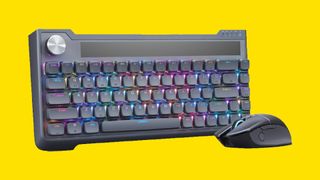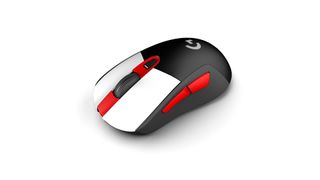We didn't realise Lenovo's solar/mechanical charging peripherals were a wind up, but they absolutely are
When we're wrong, we're wrong, but my goodness who could have possibly predicted this.

Dear readers, we, or more precisely, I, have made a mistake. When I wrote my article about Lenovo's solar and mechanical energy harvesting keeb and mouse combo, I assumed that these devices must somehow gather its mechanical energy charge by the power of typing or the movement of daily use, as this would make some degree of sense. No-one, least of all me, could have predicted that these prototype peripherals harvest energy by using what are essentially integrated fidget spinners.
Oh no, I'm not joking. PCMag UK went hands on with the pairing at CES and it turns out Lenovo's new proof of concept peripherals charge with the power of your nervous energy. See that dial in the top left corner of the keeb? We all assumed it was a volume wheel or media control. Turns out it's actually the way Lenovo's engineers envision you topping up the charge of your device, by spinning it round and round with your finger.
It gets better, or perhaps indeed, worse. Five minutes of spinning apparently equates to just half an hour's worth of charge. Read that again. Five minutes of non-stop spinning, enough to surely make your finger feel the strain, for just 30 minutes worth of keyboard usage time. I can believe that kinetic energy harvesting is a lossy process and that you'd need a lot of continued input to deliver a meaningful amount of charge.
But spinning a little wheel like a confused hamster for five entire minutes to gain what might not even be one well-thought-out email's worth of typing? I'm sorry, but no.
But what about that mouse? Again, the assumption would be that a mouse, being an object that is constantly moved around your desk during normal usage of a PC. Surely it would be harvesting its energy from said movement, perhaps by using some sort of mechanical ball system like an old fashioned squeaker to transfer all that wasted energy into something useful, like electrical charge.
Wrong again! No, the mouse instead requires you to pop out an embedded ring from underneath and wind it to gather some charge. The efficiency quoted here seems better, although not by much, as according to the specifications you should get 30 minutes of charge out of a whole solid minute of winding your mouse like it's a spring driven children's toy, wind-up torch, or a mantlepiece clock. So that's alright then.

Best gaming mouse: the top rodents for gaming
Best gaming keyboard: your PC's best friend...
Best gaming headset: don't ignore in-game audio
I normally avoid this sort of cliché, but my mind, dear readers, has been boggled. Never in a month of infinite Sundays would I have predicted this, and it's only right that I hold my hands up and take the blame.
The biggest gaming news, reviews and hardware deals
Keep up to date with the most important stories and the best deals, as picked by the PC Gamer team.
I have failed to deduce that rather than, y'know, harvesting the mechanical energy you already put into a device by actually using it, Lenovo would instead suggest that you should manually wind things round and round to gather what equates to an absolutely miniscule amount of charge.
For what it's worth, I am very sorry. Not really. But let nobody say that I don't admit my mistakes, and punish myself appropriately. I'm going to go and sit in the corner and think about what I've done, and if anybody has any fidget toys I could spin while I'm over there to pass the time, it'd be much appreciated.
_____________________________________
PC Gamer's CES 2024 coverage is being published in association with Asus Republic of Gamers.

Andy built his first gaming PC at the tender age of 12, when IDE cables were a thing and high resolution wasn't. After spending over 15 years in the production industry overseeing a variety of live and recorded projects, he started writing his own PC hardware blog in the hope that people might send him things. And they did! Now working as a hardware writer for PC Gamer, Andy's been jumping around the world attending product launches and trade shows, all the while reviewing every bit of PC hardware he can get his hands on. You name it, if it's interesting hardware he'll write words about it, with opinions and everything.
Most Popular






